Posts by: Matin Durrani
Sun, sea, sand – and science

Paradise for physicists – the scene just metres from the venue for the 50th anniversary meeting of the Brazilian Physics Society in Natal.
By Matin Durrani in Natal, Brazil
From London via Lisbon, I arrived yesterday evening in Natal – a city of 800,000 people on the north-eastern tip of Brazil – for the 50th anniversary meeting of the Brazilian Physics Society (SBF).
I was invited by Ricardo Galvão, previous SBF president and chair of the organizing committee, to take part in a session later in the five-day meeting about the development of physics over the next two decades.
As editor of Physics World, which is published by the Institute of Physics (IOP), I’ll be joined by representatives from other physical societies around the world.
View all posts by this author | View this author's profile
The September 2016 issue of Physics World is now out
By Matin Durrani
The cover story in the September 2016 issue of Physics World magazine – now live in the Physics World app for mobile and desktop – reveals the fascinating new field of “crowd breath research”, which can even shed light on how cinema audiences react during the changing scenes in a movie. You can read the article here on physicsworld.com too.
The September issue also shows how to do crystallography without crystals, explains how first data from the Gaia spacecraft could revolutionize astronomy (see the above video for more on that), and contains one physics teacher’s fascinating story about what she did to change her school’s gender balance.
Don’t miss either reader feedback on the potential impact of Britain leaving the EU on physics or Robert P Crease’s Critical Point column on why science denial is one of the most important issues in the US presidential campaign.
View all posts by this author | View this author's profile
Physics World 2016 Focus on Vacuum Technology is out now
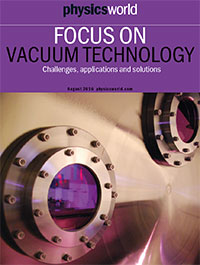 By Matin Durrani
By Matin Durrani
I’m pleased to say that the latest focus issue of Physics World, which explores the many fascinating applications of vacuum science and technology, is now out.
Plasma processing is a strong theme this year, as we discover why tools and techniques developed as part of the boom in semiconductor fabrication are now benefiting biomaterials. Elsewhere, we reflect on the strengths of the vacuum community with outgoing IUVSTA president Mariano Anderle.
And, as always, this vacuum focus issue provides a great chance to catch up with major industry players, including Pfeiffer Vacuum, Agilent, Honeywell and Edwards, to examine the latest instrument upgrades and trends across the sector.
View all posts by this author | View this author's profile
From WiFi to LiFi: the August 2016 issue of Physics World is out now
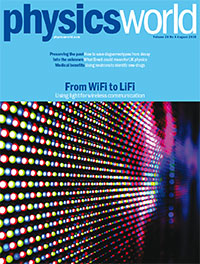 By Matin Durrani
By Matin Durrani
Over the past year the world’s computers, mobile phones and other devices generated some 12 zettabytes of data. And by 2020 that number is predicted to rise to 44 zettabytes – nearly as many bits as there are stars in the universe.
In the August 2016 issue of Physics World magazine – now live in the Physics World app for mobile and desktop – Harald Haas from the University of Edinburgh in the UK explains how the humble household light bulb could soon be transformed into the backbone of a revolutionary new wireless communications network based on visitible light.
Known as “LiFi”, the system could not only contribute to next-generation 5G mobile-phone systems, but also unlock the potential of the “Internet of things”, create”smart” cities, help with the introduction of driverless cars and offer new ways to monitor the health of old people. You can also read the article here.
The August issue also shows how neutrons could help in the search for new drugs, why we need to solve the ethical dilemmas surrounding space mining, and how physicists are helping to save daguerreotype photographs from decay. Don’t miss either our look at the impact of Brexit on European physics.
View all posts by this author | View this author's profile
Secrets of the solar system: the July 2016 issue of Physics World is now out
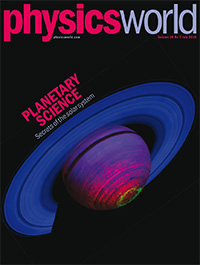 By Matin Durrani
By Matin Durrani
Members of NASA’s Juno mission are bracing themselves for the final moments of the craft’s five-year-long journey to Jupiter, which will finally reach its quarry just a few days from now (late on 4 July in North America, early morning on 5 July in Europe). There’ll be an anxious, 40-minute period of radio silence as the spinning craft fires its thrusters and slows down enough to be captured by the gas giant’s gravity.
During that time, staff at NASA’s Jet Propulsion Laboratory will be waiting, nervously, for Juno’s instruments to flicker back on and allow data-taking to begin as the craft starts a year-long orbit of the planet.
For the inside story of Juno and what it hopes to achieve, don’t miss the July 2016 special issue of Physics World magazine – now live in the Physics World app for mobile and desktop. You can also read the article here.
Devoted to planetary science, the special issue includes amazing images from NASA’s New Horizons mission to Pluto, an investigation into auroras on planets other than Earth, and an analysis of what we know about Vesta and Ceres – the two largest bodies in the main asteroid belt.
The fallout from Brexit for physics

Is the UK now a sinking ship? (Courtesy: iStock/NatanaelGinting)
By Matin Durrani, Editor, Physics World
Amid all the noise and recrimination following the UK’s vote to leave the European Union (EU) in last week’s national referendum by a majority of 52% to 48%, I was reminded of a comment that Nicola Clase – Sweden’s ambassador to Britain – made to Times columnist David Aaronovitch before the referendum. When he sought her views on a potential British exit from the EU (Brexit), Clase replied: “It’s like when a child desperately wants to pee in his pants and does it. At first there’s a feeling of relief and for a few moments it’s nice and warm. Then he’s just cold and wet.”
It was a flippant comment for sure, but not far wide off the mark. As a new week dawns, physicists in the UK – and beyond – are coming to terms with the enormity and liable consequences of the vote. A poll by Nature in March showed that the vast majority of UK scientists were overwhelmingly in support of the EU, with 83% saying “no” to an exit. Although, legally, the outcome of the referendum does not have to be acted upon, we can expect huge and completely unnecessary uncertainty over the next few months, if not longer.
Learned societies in the UK, such as the Institute of Physics, which publishes Physics World, as well as the Royal Society and the Royal Astronomical Society, have been putting a brave face on the prospect of Britain quitting the EU. They underlined the importance of maintaining free movement of scientists to and from the UK, and ensuring British scientists continue to have access to EU research funds and EU-supported facilities. It will be great if those principles and policies remain in place – but there is no guarantee they will. In any case, why should the rest of the EU now want to bother making life easy for the UK as it negotiates a Brexit?
View all posts by this author | View this author's profile
Chatting about Chinese computing
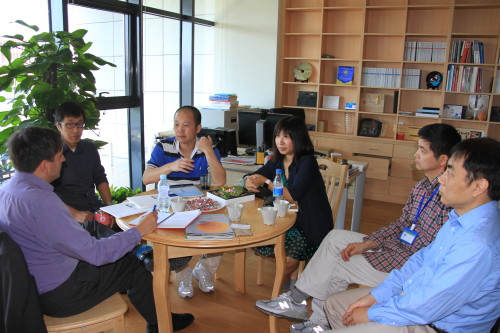
Calculated efforts: Matin Durrani (far left) in conversation with staff at the Beijing Computational Science Research Center, including Hai-Qing Lin (third left). (Courtesy: Mingfang Lu)
By Matin Durrani in Beijing, China
The last couple of days in the Chinese capital have been unusually damp and cool for the middle of June. Today, however, dawned sparklingly sunny as I headed off with my colleague Mingfang Lu from the Beijing office of the Institute of Physics, which publishes Physics World, to the Beijing Computational Science Research Center (CSRC) on the outskirts of the city.
Located on a shiny new software park, this sleek, five-storey building opened in March last year and looks just how you might expect the headquarters of IKEA to be – all minimalist corridors, big glass windows and the odd work of art dotted around. There’s even a fitness room in the basement. It’s currently got 43 full-time faculty, a third of whom are physicists, making this 45,000 m2 building – roughly the size of seven football pitches – seem remarkably sparse.
View all posts by this author | View this author's profile
Tsinghua University moves on up
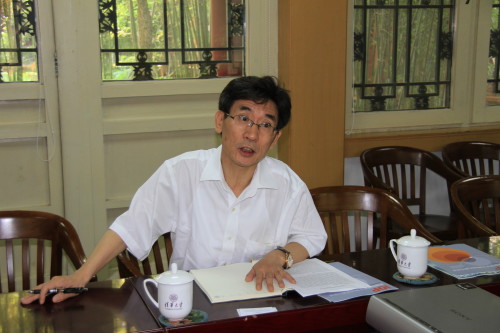
Figures at the ready: Qi-Kun Xue from Tsinghua University, which has 40,000 students. (Courtesy: Mingfang Lu)
By Matin Durrani in Beijing, China
I like big cities so I feel quite at home in Beijing with its skyscrapers, highways and endless traffic. Still, it was a pleasure yesterday on the third day of my visit to the Chinese capital to arrive at the green lawns of Tsinghua University. Situated in a former imperial garden, the university was founded in 1911 and is one of the top institutions in the country. According to the 2015–16 Times Higher Education rankings, it’s also the fifth best in Asia.
Quite why Tsinghua is so well rated quickly became clear as I listened to the numbers reeled off by Tsinghua’s vice-president for research Qi-Kun Xue: the university has 6000 research faculty and staff, a total research budget of $700m, and more than 40,000 students (two-thirds at postgraduate level). Like much of modern China, it’s benefiting from the government’s long-term commitment to growth through investment in facilities and infrastructure.
View all posts by this author | View this author's profile
China’s chief Moon scientist Ziyuan Ouyang outlines lunar plans
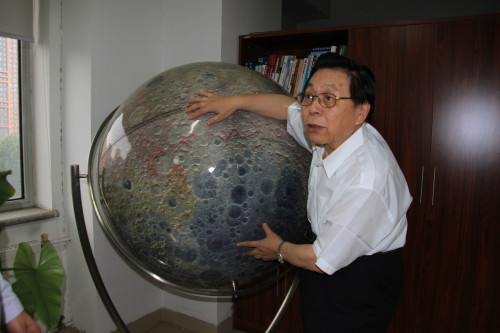
The Moon man: Ziyuan Ouyang in his office at the National Astronomical Observatories with a lunar globe covered with images taken by Chinese craft. (Courtesy: Mingfang Lu)
By Matin Durrani in Beijing, China
I caught up this morning on the second day of my visit to Beijing with Ziyuan Ouyang, chief scientist of China’s Moon programme at the National Astronomical Observatories, which lies not far from the city’s iconic “bird’s-nest” Olympic stadium.
I’d first met Ouyang on my last visit in 2011 when the country had so far launched two lunar missions – Chang’e 1 (which orbited the Moon for 18 months before crash-landing onto the lunar surface) and Chang’e 2 (another lunar orbiter that later moved off into interplanetary space).
China’s lunar efforts have continued and Ouyang explained to me what has happened since my last visit – and what the country plans to do next.
View all posts by this author | View this author's profile
China eyes new high-energy collider
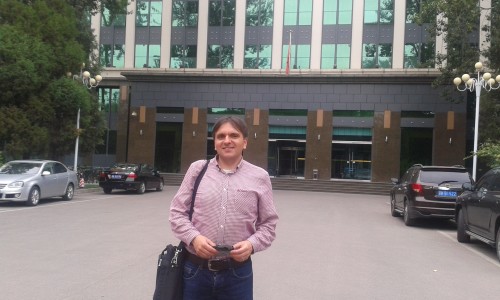
Matin Durrani outside the Institute of High Energy Physics in Beijing before interviewing Xinchou Lou.
By Matin Durrani in Beijing, China
I had just landed in Beijing this morning when I saw an e-mail from my colleague Mingfang Lu waiting for me on my phone. Mingfang, who’s editor-in-chief at the Beijing office of the Institute of Physics, which publishes Physics World, has been helping me to organize my itinerary for the next week as I gather material for our upcoming special report on physics in China. You may remember we published a Physics World special report on China in 2011 but so much has happened since then that we felt it’s easily time for another.
Mingfang’s e-mail was to say we would be off at 2.30 p.m. to interview Xinchou Lou, a particle physicist at the Institute of High Energy Physics, about the country’s ambitious plans for a “Higgs factory”. If built, this 240 GeV Circular Electron–Positron Collider (CEPC) would be a huge facility (50 km or possibly even 100 km in circumference) that will let physicists study the properties of the Higgs boson in detail. I say “if”, but knowing China’s frenetic progress in physics, it will almost certainly be a case of “when”.
View all posts by this author | View this author's profile